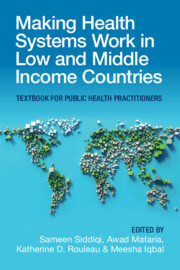 Making Health Systems Work in Low and Middle Income Countries
Making Health Systems Work in Low and Middle Income Countries What Works!
from Section 2 - Transforming Health Systems: Confronting Challenges, Seizing Opportunities
Published online by Cambridge University Press: 08 December 2022
Poor quality of care is a leading cause of excess morbidity and mortality in low- and middle- income countries (L&MICs). Improving the quality of health care is complex, yet the health care sector has benefitted from many experiences in other industries and developed its own approaches to quality improvement (QI). It is challenging to identify what works in each situation, make the intended improvements, and ensure it is well measured and sustained. Yet there are several examples from L&MICs that offer a lot of learning and illustrate those factors that underpin successful experiences in QI. This Chapter looks at the evolution of QI in health care over time; the types of health care QI approaches, and their relationship with patient safety and UHC; the opportunities to address the commonly occurring health care quality and safety challenges, as well as what works or does not work in L&MICs.
To save this book to your Kindle, first ensure [email protected] is added to your Approved Personal Document E-mail List under your Personal Document Settings on the Manage Your Content and Devices page of your Amazon account. Then enter the ‘name’ part of your Kindle email address below. Find out more about saving to your Kindle.
Note you can select to save to either the @free.kindle.com or @kindle.com variations. ‘@free.kindle.com’ emails are free but can only be saved to your device when it is connected to wi-fi. ‘@kindle.com’ emails can be delivered even when you are not connected to wi-fi, but note that service fees apply.
Find out more about the Kindle Personal Document Service.
To save content items to your account, please confirm that you agree to abide by our usage policies. If this is the first time you use this feature, you will be asked to authorise Cambridge Core to connect with your account. Find out more about saving content to Dropbox.
To save content items to your account, please confirm that you agree to abide by our usage policies. If this is the first time you use this feature, you will be asked to authorise Cambridge Core to connect with your account. Find out more about saving content to Google Drive.